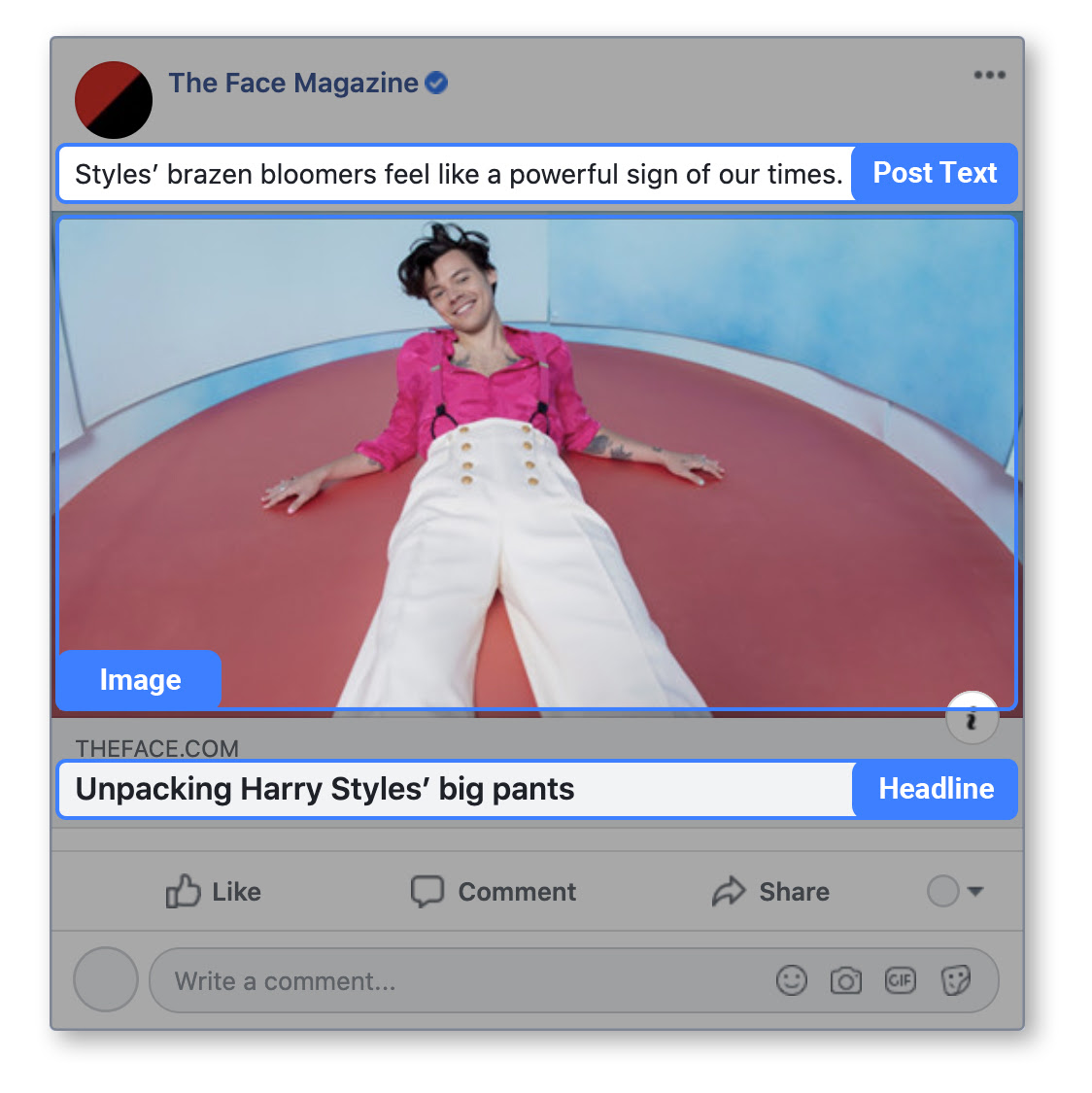I’ve been writing here often about the impact of Facebook ad creatives. How to set them up for success, A/B testing, wording, and much more.
One of the biggest challenges when it comes to putting together creatives is deciding what elements of the creatives you should concentrate on in order to have the biggest impact. That’s what I want to talk about this week, so let’s dive in.
Anatomy of a Facebook Ad
I want to take a moment to set the stage and make sure we’re speaking the same language. There are countless ad formats out there. For today, I’m only going to be addressing the standard Facebook image ad.
There are several components within a Facebook ad, and there are a gazillion different names that people use for these components. For our purposes, I put together an (extremely dinky-looking) and hopefully handy diagram of the most basic Facebook ad, no CTAs, descriptions, disclosures. Just pure Harry Styles and His Pants magic:
These tend to be the primary components of any Facebook image ad. There are, of course, other sections in some ad formats: CTA buttons, article descriptions, and more. These three, though, are the ones that are most often changed and ideated to create multiple ad variations.
Each of these components plays a unique role in reaching out to the user:
- The image: Grabs initial attention
- The headline: Tells the user what the content is about
- The post text: Adds context, commentary, or editorial color to a post
Post Text! Huh! What is it Good For?
In terms of text components, we have no real way of knowing what a user sees first — is it the headline or the post text? Logic dictates that since the post text is on top, it’s visible first, so that’s what the user sees first. But whether or not that’s the case, the post text plays an incredibly important role. A good post text will outline the value of what’s being promoted, acting as the primary lure to drive interest from the user.
That being said, images and headlines tend to get the most attention when it comes to ad units in general (not just on Facebook). A lot of ad platforms don’t even have the option of adding a post text. Taboola, Outbrain, and other native ad networks live on headline and image alone.
Regardless of the channel, this can lead people who run paid campaigns to spend the most time optimizing those two elements. I’ve recently come across several advertisers that forgo the post text altogether on Facebook, either copying in the headline text or leaving it blank.
That, on the whole, is a mistake. And we have some data to prove it.
Putting Post Text to the Test
You know how much we love A/B testing at Keywee. And no matter what, we always continue to test our assumptions to make sure that they’re sound. In a recent A/B test, we tried to understand the overall impact of post text on the performance of the ad.
We went about it very simply: Testing 31 ad sets, we kept all of the ad elements the same, with the exception of the post text, for which we created 2 variations. The two data points we looked at were CPC and CTR — the building blocks of any ad campaign and metrics that we can judge objectively.
Our goal was simple: How much did those two metrics change from ad to ad?
When the rubber hit the road, the results supported the idea that post text matters. It can even matter a lot. On average, different post texts resulted in a 15% difference in CPC and a 17% difference on CTR. The greatest difference in CPC was 46%, and the greatest difference in CTR was a whopping 75%.
Do you want to learn more about how to write great text for your ads? Sign up for our upcoming webinar, 5 Essential Rules for Writing Creatives That Convert, where we’ll talk you through the nitty gritty.


